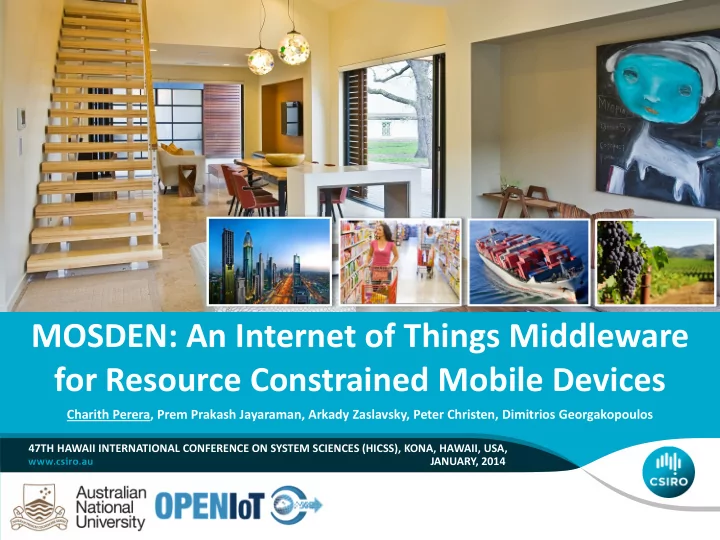

MOSDEN: An Internet of Things Middleware for Resource Constrained Mobile Devices Charith Perera, Prem Prakash Jayaraman, Arkady Zaslavsky, Peter Christen, Dimitrios Georgakopoulos 47TH HAWAII INTERNATIONAL CONFERENCE ON SYSTEM SCIENCES (HICSS), KONA, HAWAII, USA, JANUARY, 2014
Agenda • Background and The Problem • Functional Requirements • Objectives and Assumptions • MOSDEN: Architectural Design • Implementation • Experimentation, Evaluation and Results • Future Work and Research Directions Slide 2 of 23
Background and The Problem Large number of sensors Heterogeneity Resource limitations Real-time Decision Slide 3 of 23
Functional Requirements Main: Establish Communication between Sensors and Data Analytic Device Multi-Protocol Processing-ability Extendibility Usability Middle-man Heterogeneity Configurability Slide 4 of 23
Real World Scenario The Australian Plant Phenomics Facility
Australian Agriculture • Agricultural research obtains $AUS1.2 billion per annum • Fourth largest wheat and barley exporter after US, Canada and EU • BUT has to deal with scarcity of resources: Water quality and quantity Low soil fertility Slide 6 of 23
• Grains Research and Development Corporation (GRDC) trials plant varieties in very many 10m x 10m plots across Australia. • Every year, Australian grain breeders plant up to 1 million plots across the country to find the best high yielding • Information sources about plant variety performance: • Site visits • Australian Bureau of Meteorology • Issues in current practices: • Site visits are expensive and time-consuming (e.g., 400km away) • Lack of accurate information limits the quality of results Slide 7 of 23
Why Configuration matters? • Monitoring/Sensing strategies (data collection frequency, real- time event detection, data archiving for pattern recognition, etc.) need to be changed depending on the time of the day, time of the year, phase of the growing plant, type of the crop, energy efficiency and availability, sensor data accuracy, etc… Need to be considered in developing a solution: • Agricultural/biological scientists and engineers do not know much about computer science. • Users focus on what they want • Learning curve, usability, processing time, dynamicity of sensors… Slide 8 of 23
Phenonet: A Distributed Sensor Network for Phenomics • Aim is to Improve yield by improving crop selection process. How? • Sensor-based monitoring and Sophisticated data analysis • Combined research effort from CSIRO’s ICT Centre and High Resolution Plant Phenomics Centre Slide 9 of 23
Objectives and Assumptions Categorization of IoT devices based on their computational capabilities High Price Low Price High Capability Low Capability Wall-mounted Low-cost Devices with a computational device screen powered by without screen Android, capability powered by Android, equals to a modern capabilities equals to a mobile phone Raspberry Pi Slide 10 of 23
Mobile Sensor Data Engine (MOSDEN) • Can be installed on Android powered devices* • Can collect data from both internal and external sensors • Can perform preliminary data filtering and fusing tasks (e.g. AVG, comparison <>==) • Heterogeneity addressed through plugins Slide 11 of 23
MOSDEN and Cloud Communication Slide 12 of 23
Distribution and Installation of MOSDEN Plugins Extendible and scalable plugin architecture to support easy sensor data collection. We utilize the Android ecosystem to distribute the plugins. Slide 13 of 23
Implementation Four Screens are provided SENSORS: List all sensors supported and basic descriptions about the sensors VERTUAL SENSORS: List all active virtual sensors. Sensors type and real-time data values are listed MAPS: Show sensors’ locations on a map HOME: Settings and application control options are provided Screenshot of the MOSDEN Slide 14 of 23
Implementation Nexus 4 1 Nexus 7 2 Galaxy S 3 Screenshot of the GSN middleware where 3 devices has been connected Slide 15 of 23
Experimentation and Evaluation 1 Device 1 (D1): Google Nexus 4 mobile phone, Qualcomm Snapdragon S4 Pro CPU, 2 GB RAM, 16GB storage, Android 4.2.2 (Jelly Bean) 2 Device 2 (D2): Google Nexus 7 tablet, NVIDIA Tegra 3 quad-core processor, 1 GB RAM, 16GB storage, Android 4.2.2 (Jelly Bean) 3 Device 3 (D3): Samsung I9000 Galaxy S, 1 GHz Cortex-A8 CPU, 512 MB RAM, 16GB storage, Android 2.3.6 (Gingerbread) Sensors used: 52 different types of sensors manufactured by Libelium Slide 16 of 23
Results and Lessons Learned • Device 3 1 GHz Cortex-A8 CPU, 512 MB RAM failed to process more than 20 parallel queries • Other devices handle well Slide 17 of 23
Results and Lessons Learned • Resource rich devices consumes more energy • Resource consumption slightly increases when workload increases Slide 18 of 23
Results and Lessons Learned • Storage requirement is very low which allows to accommodate more sensors and queries • Latency increases significantly when processing more than 20 data streams Slide 19 of 23
Results and Lessons Learned • Scalable: MOSDEN performed well even when large number of sensors data streams are connected • Extendable: Plugin architecture allows to add support to any type of sensors • Usability: Simple, easy to use, and support non-technical personal • Saving: Communication bandwidth by eliminating redundant values, combining data values, and discarding data • Distribution: MOSDEN utilizes the existing Android ecosystem where it can potentially make use of the well established application distribution channels Slide 20 of 23
Potential Applications Waste Management Environment Monitoring Smart Home Smart Infrastructure Supply chain Management
Conclusion and Future Work • Extend MOSDEN with plugin architecture to support additional reasoning and data fusing mechanisms • Support dynamic and autonomous discovery of Internet- Connected Objects (ICO) • Develop software to support easy plugin development • Develop server-side models, algorithms, techniques to support optimized sensing strategies • Evaluate the pros and cons of processing data by computational devices that are belongs to different categories • Support comprehensive event detection and real-time actuation Slide 22 of 23
Thank You! CSIRO Computational Informatics Charith Perera t +61 2 6216 7135 e Charith.Perera@csiro.au w www.charithperera.net SEMANTIC DATA MANAGEMENT / INFORMATION ENGINEERING LAB
Recommend
More recommend